
The Mongol Empire invaded and conquered much of Kievan Rus' in the mid-13th century, sacking numerous cities including the largest such as Kiev and Chernigov. The Mongol siege and sack of Kiev in 1240 is generally held to mark the end of Kievan Rus' as a distinct, singular polity. Many other Rus' principalities and urban centres in the northwest and southwest escaped destruction or suffered little to no damage from the Mongol invasion, including Galicia-Volhynia, Novgorod, Pskov, Smolensk, Polotsk, Vitebsk, and probably Rostov and Uglich.
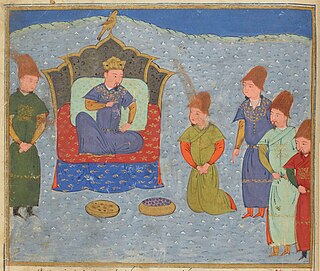
Batu Khan was a Mongol ruler and founder of the Golden Horde, a constituent of the Mongol Empire. Batu was a son of Jochi, thus a grandson of Genghis Khan. His ulus ruled over the Kievan Rus', Volga Bulgaria, Cumania, and the Caucasus for around 250 years.

The Principality or, from 1253, Kingdom of Galicia–Volhynia, historically known as the Kingdom of Ruthenia, was a medieval state in Eastern Europe which existed from 1199 to 1349. Its territory was predominantly located in modern-day Ukraine, with parts in Belarus, Poland, Moldova, and Lithuania. Along with Novgorod and Vladimir-Suzdal, it was one of the three most important powers to emerge from the collapse of Kievan Rus'. The main language was Old East Slavic, the predecessor of the modern East Slavic languages, and the official religion was Eastern Orthodoxy.
Yaroslav II Vsevolodovich, also transliterated as Iaroslav, was Grand Prince of Vladimir from 1238 to 1246. He helped to restore his country and capital after the Mongol invasion.
Vsevolod IV Svyatoslavich the Red or Vsevolod Chermnyi was Grand Prince of Kiev. He was also Prince of Chernigov (1204–1206/1208) and Belgorod Kievsky (1205). His baptismal name was Daniil.

Michael of Chernigov or Mikhail Vsevolodovich ; c. 1185 – 20 September 1246) was Grand Prince of Kiev ; he was also Prince of Pereyaslavl (1206), Prince of Novgorod-Seversk (1219–1226), Prince of Chernigov, Prince of Novgorod, and Prince of Galicia (1235–1236).

Daniel of Galicia or Danylo Romanovych was a King of Ruthenia, Prince (Kniaz) of Galicia (Halych) (1205–1255), Peremyshl (1211), and Volodymyr (1212–1231). He was crowned by a papal archbishop in Dorohochyn in 1253 as the first King of Ruthenia (Rus') (1253–1264).

The Church of the Tithes or Church of the Dormition of the Virgin was the first stone church in Kyiv. Originally it was built by the order of Grand Prince Vladimir (Volodymyr) the Great between 989 and 996 by Byzantine and local workers at the site of death of martyrs Theodor the Varangian and his son Johann. It was originally named the "Church of Our Lady", in honor of the Dormition of the Theotokos. The church was ruined in 1240 during the siege of Kyiv by Mongol armies of Batu Khan.

Roman Mstislavich, also known as Roman the Great, was a Rus’ prince and a member of Izyaslavichi of Volhynia clan. He founded the Romanovichi dynasty, which would rule Volhynia and Halych until 1340.

The Principality of Halych, or Principality of Halychian Rus', was a medieval East Slavic principality, and one of main regional states within the political scope of Kievan Rus', established by members of the oldest line of Yaroslav the Wise descendants. A characteristic feature of Halych principality was an important role of the nobility and citizens in political life, consideration a will of which was the main condition for the princely rule. Halych as the capital mentioned in around 1124 as a seat of Ivan Vasylkovych the grandson of Rostislav of Tmutarakan. According to Mykhailo Hrushevsky the realm of Halych was passed to Rostyslav upon the death of his father Vladimir Yaroslavich, but he was banished out of it later by his uncle to Tmutarakan. The realm was then passed to Yaropolk Izyaslavich who was a son of the ruling Grand Prince Iziaslav I of Kiev.
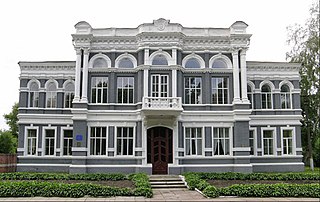
Sosnytsia is a rural settlement in Koriukivka Raion (district) of Chernihiv Oblast (province) in north-central Ukraine. It is located on the west bank of the Ubid River, a tributary of the Desna river, some 90 km (56 mi) from Chernihiv, the oblast center. It hosts the administration of Sosnytsia settlement hromada, one of the hromadas of Ukraine. Population: 6,589.
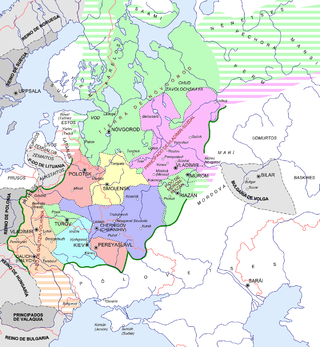
The inner Principality of Kiev was a medieval East Slavic state, situated in central regions of modern Ukraine around the city of Kiev.
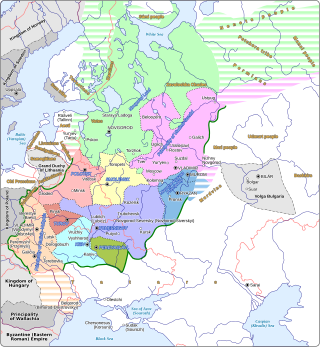
Mstislav III Glebovich was an Olgovichi prince. He was probably prince of Rylsk (1212–1239/1241) and of Chernigov (1235–1239/1241). During his reign, the Tatars invaded and pillaged the towns of the Principality of Chernigov.
Roman Mikhailovich the Old was a Rurikid prince. He was Prince of Chernigov and Bryansk.

The siege of Kiev by the Mongols took place between 28 November and 6 December 1240, and resulted in a Mongol victory. It was a heavy morale and military blow to the Principality of Galicia–Volhynia, which was forced to submit to Mongol suzerainty, and allowed Batu Khan to proceed westward into Central Europe.
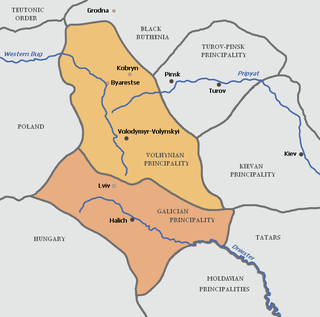
The Principality of Volhynia was a western Kievan Rus' principality founded by the Volodimerovichi prince Vsevolod in 987 centered in the region of Volhynia, straddling the borders of modern-day Ukraine, Belarus, and Poland. From 1069 to 1118, it belonged to Izyaslavichi who primarily ruled from Turov. After losing Turov to Monomakhovichi in 1105, the descendants of Iziaslav Yaroslavovich for a few years continued to rule in Volhynia. From 1154 to 1199, the Principality was referred to as the Principality of Volodymyr when the Principality of Lutsk (1154–1228) was separated.
Bolokhovians, Bolokhoveni, also Bolokhovens, were a 13th-century ethnic group that resided in the vicinity of the Rus' principalities of Halych, Volhynia and Kiev, in the territory known as the "Bolokhovian Land" centered at the city of Bolokhov or Bolokhovo. Their ethnic identity is uncertain; although Romanian scholars, basing on their ethnonym identify them as Romanians, archeological evidence and the Hypatian Chronicle suggest that they were a Slavic people. Their princes, or knyazes, were in constant conflict with Daniel of Galicia, Prince of Halych and Volhynia, between 1231 and 1257. After the Mongols sacked Kiev in 1240, the Bolokhovians supplied them with troops, but the Bolokhovian princes fled to Poland. The Bolokhovians disappeared after Daniel defeated them in 1257.
The Mongol siege, capture and sack of Chernigov, capital of the Chernigov Principality, occurred on 18 October 1239 during the westward expansion of the Mongol Empire. It was part of the 1237–1242 Mongol invasion of Kievan Rus'.

The sack of Kiev took place on 8–12 March 1169 when a coalition of 11 princes, assembled by prince Andrey Bogolyubsky of Vladimir-Suzdal, attacked the Kievan Rus' capital city of Kiev during the 1167–1169 Kievan succession crisis. The conflict, caused by the death of grand prince Rostislav I of Kiev, was between rival branches of the Monomakhovichi clan: the Iziaslavichi of Volhynia on the one hand, and the Rostislavichi of Smolensk, the Yurievichi, and the Olgovichi of Chernigov on the other. Prince Mstislav II of Kiev sought to defend Kiev against the Rostislavichi–Yurievichi–Olgovichi coalition.














